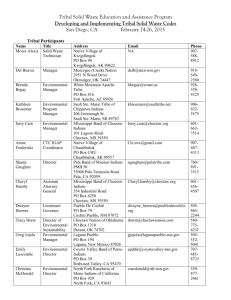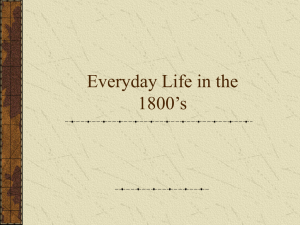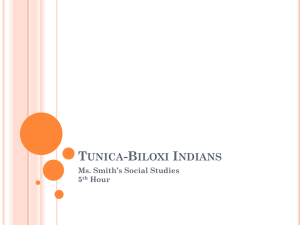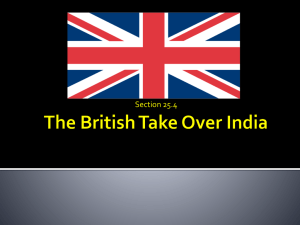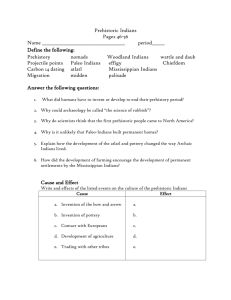8th Grade
advertisement
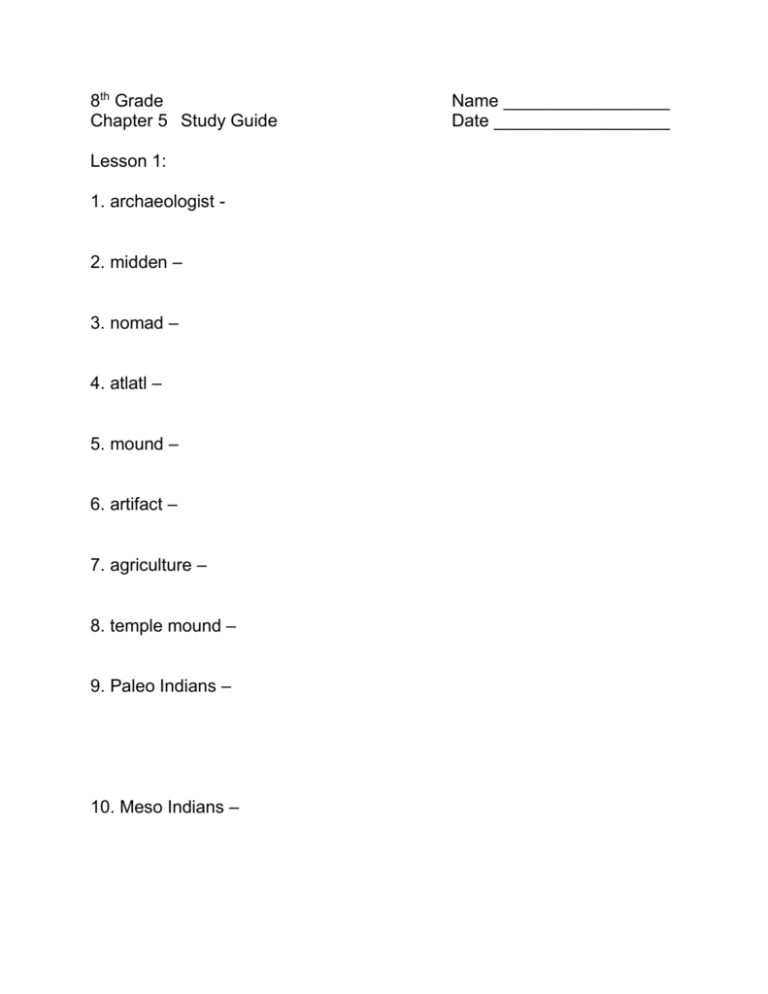
8th Grade Chapter 5 Study Guide Lesson 1: 1. archaeologist 2. midden – 3. nomad – 4. atlatl – 5. mound – 6. artifact – 7. agriculture – 8. temple mound – 9. Paleo Indians – 10. Meso Indians – Name _________________ Date __________________ 11. What are some of the artifacts left behind by the Meso Indians? 12.Early Neo Indians – 13. Late Neo Indians – 14. What places give clues about the lives of the ancient people? 15. Why was the development of the bow and arrow so important? 16, What was the purpose of the temple mounds? Chapter 5 Lesson 2 1. immunity 2. tribe 3. treaty 4. totem 5. clan 6. What is considered the beginning of the historic period? 7 . Who was the first European to travel through Louisiana? 8. Why was the Native American population decreased by 80 % from the time of Spanish exploration and French exploration? 9. As students present their projects you will write down key information about their tribes. You will be responsible for the language, traditions, location, food and shelter for each one. Atakapa Natchez Caddo Choctaw Houma Tunica-Biloxi Chitimacha Coushatta Chapter 5 Lesson 3 1. Pirougue 2. Calumet 3. How was membership into the class system achieved in most Native cultures? 4. How did child play prepare children for adult roles? 5. How do the games played by Native Americans compare to games today? 6. How did the clothing reflect their natural environment? Women – Men – Children – 7. What type of work did the men do together? 8. What were the main foods for most of Louisiana Indians? 9. Preserving ___________________ and _________________ was the purpose of religious ceremonies. 10. Name the ceremonial traditions of most Native American tribes. 11. What was the role of the war chief? 12. What was the role of the peace chief? 13. What were the reasons for going to war? 14. How did contact with Europeans change the lives of the Indians forever? 8th Grade Chapter 5 Study Guide Name _________________ Date __________________ Lesson 1: 1.archaeologist – a scientist who studies the items left behind by ancient peoples to determine how they lived 2. midden – garbage mound left by prehistoric people 3. nomad – a wanderer; a person with no settled home 4. atlatl – a throwing stick with weights used by prehistoric people to throw spears with more force for farther distances 5. mound – a raised area created by prehistoric peoples and thought to be Used for ceremonial or burial purposes 6. artifact – an item left behind ancient peoples stone, bone, pottery, tools cave paintings, weavings, skeletons, items buried with people, and trash 7. agriculture – farming 8. temple mound – a mound built by prehistoric Indians and used for religious purposes 9. Paleo Indians – oldest known Indians in Louisiana date back to 10,000 B.C. crossed beringia followed animals for food and clothing. They ate a variety of plants and animals including mastodans. Spear points are found throughout Louisiana 10. Meso Indians – 7500 B.C. ate animals such as deer, rabbit, birds, fish, clams, reptiles, seeds, roots, nuts, and fruits still nomadic but stayed in a place longer. They built houses of branches and thatch. They built mounds. 11. What are some of the artifacts left behind by the Meso Indians? Artifacts included bowls, jewelry, baskets, harpoons, bone needles, fish hooks, and shell ornaments 12.Early Neo Indians – 1000 B.C. built villages for seasonal living, developed the bow and arrow, diet was grapes, palmetto, pigweed, amaranth, fish, deer, and shellfish. They had elaborate ornaments, copper ear spools, bracelets, beads, animal tooth pendants, pottery pipes and figurines. 13. Late Neo Indians – 800 A.D. to 1500’s built villages near waterways, More permanent housing made of wattle and daub (sticks covered with mud) They lived in one place year round, they became farmers They ate beans, corn, squash, and pumpkins. They built temples on top of their mounds 14. What places give clues about the lives of the ancient people? Where they prepared food, made tools, built shelters, and conducted ceremonies 15. Why was the development of the bow and arrow so important? It made hunting easier 16. What was the purpose of the temple mounds? It is where religious ceremonies were held Chapter 5 Lesson 2 1. immunity natural resistance to disease 2. tribe a group of people who share common ancestry, language, name, and a way of living 3. treaty a formal agreement between two or more nations 4. totem a tribal symbol; an animal, plant, or natural object serving as a symbol of a clan or family 5. clan a group of people who believe themselves related by blood 6. What is considered the beginning of the historic period? When the Europeans came to America and began keeping records 7 . Who was the first European to travel through Louisiana? Hernando deSoto 8. Why was the Native American population decreased by 80 % from the time of Spanish exploration and French exploration? Diseases such as influenza, measles, smallpox, and cholera 9. As students present their projects you will write down key information about their tribes. You will be responsible for the language, traditions, location, food and shelter for each one. Atakapa – Southwest Prairie Region, they practiced cannibalism on defeated enemies. Atakapa language, they played chunkey and stickball, men were hunters and warriors Storytelling and traditional medicine, houses were brush shelters (grass and reeds around a wooden frame) Men wore breech cloths, women wore wrap around skirts of deerskin or woven fiber, they wore moccasins. The men wore hair in mohawks and used porcupine hair roaches. Both men and women had tribal tattoos. They used dogs as pack animals, they built canoes, They ate fish, oysters, shrimp, crab, deer, buffalo, alligator, fruits, nuts, and honey. They made bows and arrows and pottery from red clay. Natchez – northeastern Mississippi Floodplain regions ruled by a king. The Natchez king was called the Great Sun Great Sun usually had to listen to the opinions of a council of warriors, priests, and other important Natchez men They spoke their native Natchez language Natchez children liked to go hunting and fishing with their fathers they had corn husk dolls, toys and games to play. Teenage boys played a spearthrowing game called chunkey. Natchez mothers, like many Native Americans, traditionally carried their babies in cradleboards on their backs. Men were higherranking than women, held leadership positions, were in charge of the household, and even got to eat first. However, both genders took part in storytelling, artwork and music, and traditional medicine. They had adobe houses with thatched roofs Natchez men wore breechcloths and leather leggings. Natchez women wore wraparound skirts made of deerskin or woven fiber The Great Sun wore a fancy feathered crown, but other Natchez men usually went bare-headed. Some Natchez warriors shaved their heads except for a scalplock (one lock of hair on top of their heads.) Women usually wore their hair in one long braid Natchez men and women both painted their faces for special occasions and also decorated their bodies with complex tribal tattoos. The Natchez were farming people. They raised crops of corn, beans, pumpkins, and squash. Natchez men also hunted deer, wild turkeys, and buffalo and went fishing in the rivers. Natchez recipes included cornbread, hominy, and soups. Natchez hunters used bows and arrows or spears. Fishermen used fishing harpoons and nets. Farmers used hoes carved from hickory wood. In war, Natchez men fired their bows or fought with tomahawks and war clubs. They were known for their pottery, baskets, and woodcarvings. Caddo Northwestern or Hills region of the state Caddo band was led by a chief chosen by a council of warriors. Historically, all these chiefs were male. Today speak their native Caddo language kids tried to throw a dart through a moving hoop Caddo men were hunters and sometimes went to war to protect their families. Caddo women were farmers and also did most of the child care and cooking built tall beehiveshaped grass houses Caddo village also included a temple and a sports field. Sometimes villages were surrounded by log walls for protection Caddo Indian men wore breechcloths, sometimes with leather leggings to protect their legs. Caddo women wore wraparound skirts and poncho tops made of woven fiber and deerskin. Both genders wore earrings and moccasins. Caddo men did not usually wear shirts, but in cold weather, both men and women wore buffalo robes. Caddo men usually cut their hair in the Mohawk style or shaved their heads except for a scalplock (one long lock of hair on top of their heads.) Sometimes warriors would make this hairstyle more impressive with a colorful porcupine roach. Caddo Indian women usually wore their long hair in a bun. For special occasions, Caddo women fastened their buns with beaded hair ornaments and long trailing ribbons . The Caddos also wore tribal tattoos, and women painted their faces and bodies bright colors for special occasions. dugout canoes from hollowed-out logs, but usually they preferred to travel by land The Caddo Indians were farming people. Caddo women harvested crops of corn, beans, pumpkins, and sunflowers. Caddo men hunted for deer, buffalo, and small game and went fishing in the rivers. Traditional Caddo foods included cornbread, soups, and stews. The Caddo Indians also mined salt from underground mines, which they boiled down to use in their cooking. Caddo hunters primarily used bows and arrows. Caddo fishermen caught fish and shellfish in basket traps. Caddo warriors fired their bows or fought with lances or tomahawks. Farmers used tools such as hoes and spades, which they made from wood, carved bone, and mussel shells. The Caddos also made axes with heavy stone heads for chopping wood. They made pottery, basketry, woodcarvings. They held pow-wows where they danced and played drums. There are many legends and they enjoyed story telling. They held elaborate religious rituals Choctaw Located in the Southeast or in the Flatwoods or Blufflands Regions They spoke Choctaw language They played Toli a lacrosse stick like game Choctaw girls enjoyed guessing games and playing with beaded dolls. Chunkey, football, swimming, and footraces were also popular pastimes among Choctaw kids. Choctaw mothers, like many Native Americans, carried their babies in cradleboards on their backs Choctaw men were hunters and sometimes went to war to protect their families. Chiefs were always men. Choctaw women were farmers and also did most of the child care and cooking. Both genders took part in storytelling, artwork and music, and traditional medicine Choctaw homes were made of plaster and rivercane walls, with thatched roofs. These dwellings were about as strong and warm as log cabins The villages were surrounded with palisades Choctaw men wore breechcloths. Choctaw women wore wraparound skirts made of deerskin or woven fiber Choctaw men and women both wore their hair long, but some men cut their hair in the Mohawk style, decorating the fringe with feathers. Choctaws often painted their faces and bodies bright colors during battles, lacrosse games, and festivals. Some Choctaw men also wore tribal tattoos on their arms and legs. The Choctaw were farming people. Choctaw women did most of the farming, harvesting crops of corn, beans, squash, and sunflowers. Choctaw men did most of the hunting, shooting deer, wild turkeys, and small game. Men also caught fish in the rivers, lakes, and sea coasts. Choctaw recipes included cornbread, soups, and stews cooked on stone hearths. The Choctaws also enjoyed sassafrass tea Choctaw hunters primarily used bows and arrows. Fishermen generally used fishing spears and nets. In war, Choctaw men fired their bows or fought with tomahawks and clubs. The Choctaws were famous for their rivercane baskets, woodcarvings, and beaded artwork. Houma lived in south central Louisiana or the Mississippi Flood Plain fresh and salt water marshes. Spoke Choctaw language. They lived in Palmetto houses. Palmetto leaves were lashed onto a sapling frame. Woven in and out to create a water proof shelter. Still used by trappers today. They were a sedentary tribe with a rich culture that included dancing, crafts and a welldeveloped religion. Historically the Houma Indians were a tribe of farmers and hunters. The women tended the tribe's communal fields and grew crops like corn, pumpkin and beans, while the men hunted deer and small game with blow guns, bows and arrows, and spears. The Houma Indians used dugout pirogues to traverse the many bayous that cut through their territories. The pirogues were made from large, felled cypress trees prevalent in the area. Town centers of the Houma Indians included large ball courts and a temple where the bones of revered chiefs burned in a sacred fire. Houma Indians allowed for both male and female chiefs. The crawfish is the totem and represents kinship and protection another totem is the Istrouma a tall red stick that marked the hunting grounds of the tribes. The French called this Baton Rouge Houma men and women both wore their hair long. The Houmas often painted their faces and bodies bright colors during battles, lacrosse games, and festivals. Tunica-Biloxi located in east-central Louisiana or the Mississippi Floodplain regions They were traders of salt, arrow points, flint, horses, shell beads, pearls, and quartz. They were farmers and fishermen. They had war chief and a peace chief. Their totem symbol is the rattlesnake. They lived in villages of thatched houses surrounded by palisades. They were farmers and gatherers. They planted corn, beans, and pumkins, they used salt to season their foods which included cornbread, hominy, soups, and persimmon bread Tunica men also hunted deer, wild turkey, and buffalo, and women collected fruits, nuts, and mushrooms to use in their cooking Tunica hunters primarily used bows and arrows. In war, Tunica men fired their bows or fought with war clubs and knives. The Tunicas were known for their pottery, baskets, and woodcarvings. They also made textiles from mulberry bark, which they used to weave clothing and blankets. Both men and women usually wore their hair long. The Tunicas didn't usually paint their faces, but they did decorate their bodies with tribal tattoos Chitimacha South-central Louisiana Freshwater marsh regions celebrated every aspects of life with ceremony and dance with drum beating. Chitimacha had no form of writing, story tellers repeated the legends and history orally, thereby preserving an integral part of Chitimacha culture. Chitimacha Indians spoke their own Chitimacha language Most Chitimacha chiefs and religious leaders were men, but there were some women who held those positions too. Each of the15 villages was selfgoverning, but there was also a central government led by a grand chief. The communities were built in the middle of rivers and swamps, as protection against enemies. There were as many as 500 people in each village. They lived in a variety of different styles of permanent homes, depending on the materials close at hand, such as cane, wood and palmetto leaves. The Chitimacha grew corn for hominy and meal. They also hunted and fished, and a large part of their dietary needs was filled by the abundant variety of shellfish. They killed smaller animals with blowguns and darts made from pieces of whittled cane. They also ate bear The Chitimacha have long been known for their crafts, especially basketry. These baskets were created out of wild cane reed colored with natural dye and then woven into geometric designs Coushatta piney woods of Southwest Louisiana The Coushatta were traditionally agriculturalists, growing maize and other food crops, and supplementing their diet by hunting game. They are known for their skill at longleaf pine needle basketry They also made animal dolls out of pine needles and palm trees The land is used for Coushatta-constructed tribal housing, rice and crawfish farming and development of a new cattle raising spoken language, Koasati. they lived in Indian style houses in large villages They built huge temple mounds of dirt. These were like pyramids. On top they would place a temple or the house of a priest or chief lived in squareshaped villages of houses and small farm plots. The houses had plaster and rivercane walls with thatched roofs. These dwellings were about as strong and warm as a log cabin. They also built a larger circular lodge for town meetings, and most villages had a lacrosse field with benches for spectators. Chapter 5 Lesson 3 1, Pirougue - a dugout made by Native Americans and the French; cypress logs were partially burned and the burned section scraped out 2. Calumet – a peace pipe usually made of clay or hollow cane and decorated with feathers and other significant items 3. How was membership into the class system achieved in most Native cultures? Membership in clans were passed through the mother’s side of the family 4. How did child play prepare children for adult roles? Their play imitated adult work, they learned gender roles and skills needed as adults 5. How do the games played by Native Americans compare to games today? Chunky was like football or soccer and by using goals and it also like baseball because one player hit the ball with a pole. They also had archery, wrestling, and racing. 6. How did the clothing reflect their natural environment? Women – wore simple skirts made of mulberry bark, buffalo wool, woven palmetto leaves, Spanish moss, or buckskin Men – breechcloths made of buckskin held with a belt made of fur, fiber, or buckskin. They also wore buckskin leggings in cold weather Children – dressed simply, summers they did not wear clothing at all They all wore moccasins for footwear from deer, bear, or bison. On special occasions, both men and women wore a cape made of woven net and covered in turkey, duck, or swan feathers 7. What type of work did the men do together? They cleared land, construct houses, and build boats 8. What were the main foods for most of Louisiana Indians? Acorns, hickory nuts, mayhaw, blackberry, sweet potato, sunflower, amaranth, corn, beans, squash, deer, bison, bear, fish, oysters, shrimp,and crab 9. Preserving _balance ____ and ___harmony____ was the purpose of religious ceremonies. 10. Name the ceremonial traditions of most Native American tribes. Honoring the Sun, dancing, music, story telling, sacrificing of children 11. What was the role of the war chief? He was the military leader, decided when to go to war, 12. What was the role of the peace chief? He was in charge of normal day to day activities in the tribe. He acted as the judge in criminal cases 13. What were the reasons for going to war? When they felt threatened by their neighbors or to acquire captives 14. How did contact with Europeans change the lives of the Indians forever? They changed from a hunting and agriculture society to one that depended on trade, they were expected to serve as soldiers or slaves, the diseases that the Europeans brought destroyed many of them.


